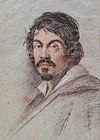Michelangelo Merisi da Caravaggio was an Italian artist active in Rome, Naples, Malta and Sicily between 1593 and 1610. He is commonly placed in the Baroque school, on which he had a formative influence.
Even in his own lifetime Caravaggio was enigmatic, fascinating, and dangerous. He burst upon the Rome art scene in 1600, and never afterwards lacked commissions or patrons, yet handled his success atrociously. In 1606 he killed a young man in a brawl and fled Rome with a price on his head. In Malta in 1608 he was involved in another brawl, and yet another in Naples in 1609, possibly a deliberate attempt on his life by unidentified enemies. By the next year, after a career of little more than a decade, he was dead.
Famous while he lived, Caravaggio was almost completely forgotten in the centuries after his death, and it was only in the last few decades of the 20th century that he has been rediscovered. Yet despite this his influence on the common style which eventually emerged from the ruins of Mannerism, the Baroque, was profound. Andre Berne-Joffroy, Paul Valéry’s secretary, said of him: "What begins in the work of Caravaggio is, quite simply, modern painting."
